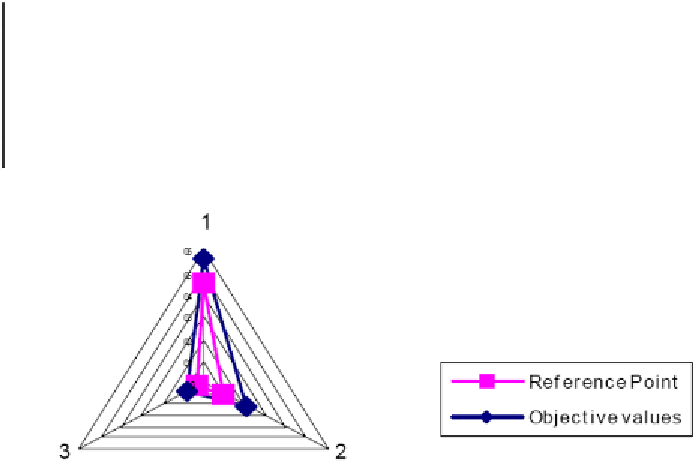Environmental Engineering Reference
In-Depth Information
Table 3.3. Iteration sequence for DM2
Reference Point
Objective Values
q
q
q
q
q
q
q
q
k
2
4
2
4
1
0.50
0.50
0.03
0.10
0.54
0.26
0.07
0.00
2
0.50
0.20
0.03
0.10
0.54
0.24
0.07
0.04
3
0.50
0.10
0.03
0.10
0.59
0.19
0.06
0.00
4
0.45
0.10
0.03
0.10
0.56
0.21
0.08
0.00
Figure 3.3. The star representation of the result of the iteration process for DM2.
To reach the final decision, DM1 and DM2 should discuss their two solutions in order to
agree upon a compromise. To solve the decision the following questions have to be answered:
is it worthwhile to spend additional 0.54M€ a year (moving costs from 55.18M€ to 55.56€,
corresponding to the gap from
q
1
=0.52 for DM1 to
q
1
=0.56 for DM2), in order to reduce of
25.21 tons per year the amount of unrecycled waste (moving from 525.7€ to 501.8 tons per
year corresponding to the gap from
q
2
=0.30 for DM1 to
q
2
=0.21 for DM2)? Which solution is
most feasible and robust according to the decisional variables?
4. Conclusion
The complexity of environmental problems requires the development and application of
new tools capable of processing not only numerical aspects, but also experience from experts
and wide public participation, which are all needed in decision-making processes.
Environmental decision support systems (EDSSs) are among the most promising approaches
to confront this complexity (Poch, 2004). A wide range of EDSS have been developed in the
last two decades, and there are many more currently under development. Rizzoli and Young
(1999) seeks to provide a framework within which the different EDSS can be placed and
compared according to the approaches used in their development.
The role of Decision Support Systems (DSS) for environmental systems planning and
management, with specific attention to the use of forest biomasses for energy production, and
energy and material recovery from the planning and management of urban solid waste is here
investigated. The two mentioned issues are treated in two different sections to highlight the
legislative and technological differences beyond the “treatment” and the “possibilities of use”

























Search WWH ::

Custom Search